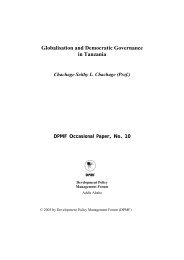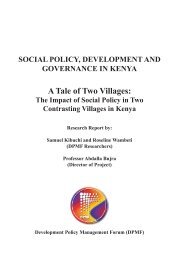From the Lagos Plan of Action (LPA) - DPMF.org
From the Lagos Plan of Action (LPA) - DPMF.org
From the Lagos Plan of Action (LPA) - DPMF.org
Create successful ePaper yourself
Turn your PDF publications into a flip-book with our unique Google optimized e-Paper software.
26 <strong>DPMF</strong> Occasional Paper No. 1311. Negotiations can be better handled to reduce tension betweenconditionality and national sovereignty;12. Multilateral institutions should accept greater responsibility forfailed programs 19 .The African critique <strong>of</strong> SAPs was loud and clear from <strong>the</strong> beginning i.e.since SAPs were introduced in <strong>the</strong> early 1980s. That <strong>the</strong> WB came outwith <strong>the</strong>se criticisms openly by 1988 meant it had known about <strong>the</strong>mmuch earlier. Yet, despite such prior knowledge, <strong>the</strong> WB/IMF proceededwith <strong>the</strong> implementation <strong>of</strong> SAPs, with only slight technicalmodifications.The adverse and negative impacts <strong>of</strong> SAPs are now well known, as are <strong>the</strong>strong reactions <strong>of</strong> African <strong>of</strong>ficials and intellectuals against SAPs. Themost important formal reaction to SAPs was <strong>the</strong> ECA’s 1989 AfricanAlternative Framework to Structural Adjustment Programmes (AAF-SAPs), already discussed in <strong>the</strong> context <strong>of</strong> African Initiatives. Amongsto<strong>the</strong>r sharp and serious critiques levelled against SAPs by Africanintellectuals (starting with SAPs genesis in <strong>the</strong> Berg Report) is ThandikaMkandawire’s book “Our Continent, our Future” (1999).By <strong>the</strong> end <strong>of</strong> <strong>the</strong> 1980s and throughout <strong>the</strong> 1990s, externals’ perspectivefor African development had become <strong>the</strong> dominant, if not <strong>the</strong> onlydirecting principle <strong>of</strong> development in almost all African countries. Indeed<strong>the</strong> practical power <strong>of</strong> <strong>the</strong> WB/IMF and <strong>the</strong> Donor community, <strong>of</strong>tencollectively referred to as <strong>the</strong> international community, to intervene anddirect plans, programmes, projects and actual decision making by Africangovernments has become established and accepted in government circlestoday.In <strong>the</strong> meantime in 1989, <strong>the</strong> WB came out with ano<strong>the</strong>r report labelledLong Term Perspective Studies (LTPS) that proposed a global coalition <strong>of</strong>Donors and Africans to effectively direct <strong>the</strong> intellectual framework andstrategies <strong>of</strong> long-term development in Africa. The Global Coalition forAfrica was thus established and remains an institution that is stilloperating today. In <strong>the</strong> 1990s, however, <strong>the</strong> international communitybegan to intensify its coordination at different levels, without <strong>the</strong>participation <strong>of</strong> Africans. The WB/IMF, <strong>the</strong> EU, <strong>the</strong> DAC, individualdonor countries, <strong>the</strong> Paris and London Clubs etc. started to coordinate and19 Ibid, p. vii and viii.




